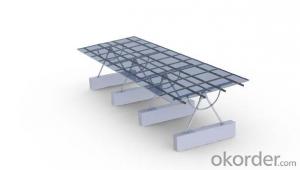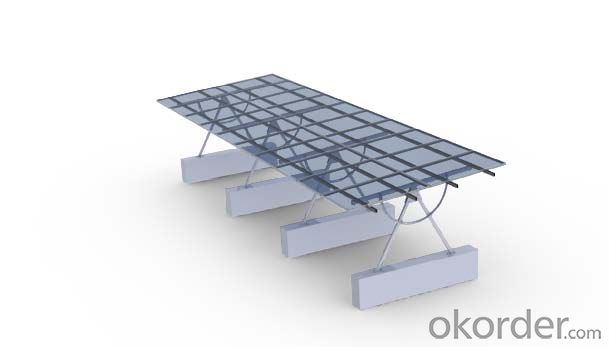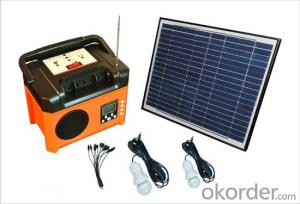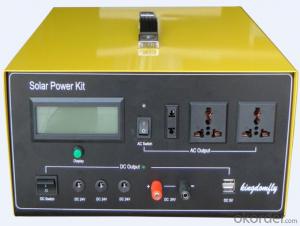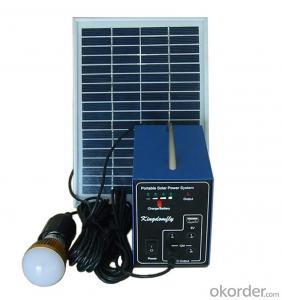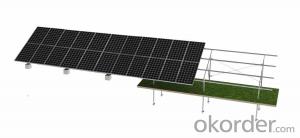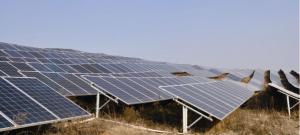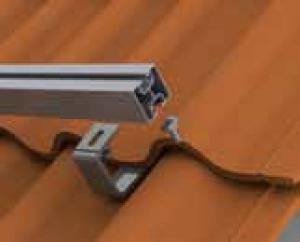Infusion Solar Energy Systems - Double Pile Manual Solar Mounting System
- Loading Port:
- China Main Port
- Payment Terms:
- TT OR LC
- Min Order Qty:
- -
- Supply Capability:
- -
OKorder Service Pledge
OKorder Financial Service
You Might Also Like
Packaging & Delivery
Packaging Detail:Normal package seaworthy
Delivery Detail:15 days
Specifications
Easy installation Competitive price TUV&SGS test report & CSA certification 15-warranty
Specifications
1) Super smooth beautiful appearance,outstanding quality,large supply.
2) Available in customized surface finishes.
3) Well machined,for example,cutting,drilling and milling with excellent tolerance.
4) Meet with customer’s designs and supply you best price.
5)Usages:Supply for solar panel modules.
Technical characteristics
Installation site:
ground,hillside,and grassland
Installation angle
it is based on customers’ requirements
Installation height
it is basedon customers’ requirements
Solar panel type; with or without frame
Components arrangement :horizontal or vertical
Support track
aluminum alloy extrusion
Quality warranty
15 years
Advantages
1)Quick installation: with high degree of pre-installed rate, the system could be easily installed by using galvanized carbon steel rails for PV Stent, and specially designed connection parts of the PV bracket, which could reduce installation time and cost greatly.
2)Offer unmatched durability: with all structural components comprised of high class stainless steel and anodized aluminum alloy, it is designed for 25 years service life and backed by 15 years warranty.
3)Stand up to extreme weather: The SuninTek solar mount is designed to stand up to the extreme weather complied with the AS/NZ 1170 and other international structure load standard by the skilled engineer. The main support components also have been tested to guarantee its structure and load-carrying capacity.
4)Provide broad installation flexibility: These systems accommodate most commercially available framed solar panels , and they can scale easily from small to large, multi-megawatt installations.
5)Diversified Application: The PV mounting system produced can be adopted by various types of PV cells panels which you can find in the market. It can serve for both mini solar power system and huge plant with megawatt capability.
Main features
1. Installation cost savings.
2. Save installation time.
3. Increase the mechanical strength of solar energy mounting to ensure that wind requirements.
4. The outdoor for installation of solar energy.
5. Length can be customized according to customers.
6. Service life of up to 25 years.
7. Products through the international certification.
8. Stent material composition of the galvanized steel and aluminum.
9. 15 years system and structural guarantee.
10.Flexible post spacing withstands different wind & snow loads.
11. High quality material in Aluminium 6005-T5 and SUS 304.
12.Screws and nuts go with every components needed.
13.Mechanical calculation and reliability tested to ensure highest product quality.
- Q: How much space is needed to install a solar energy system?
- The amount of space required for installing a solar energy system varies based on several factors such as the capacity of the system, the type of solar panels used, and the available sunlight. On average, for residential installations, a solar energy system typically requires around 100-400 square feet of roof space per kilowatt (kW) of solar capacity. However, ground-mounted systems can require more space, especially for larger installations. It is essential to conduct a site evaluation to determine the specific space requirements for a solar energy system.
- Q: Can solar energy systems be used in all regions?
- No, solar energy systems can be used in all regions, but their efficiency and effectiveness may vary depending on factors such as sunlight availability, weather conditions, and geographical location.
- Q: Can solar energy systems be used for waste management?
- Yes, solar energy systems can be used for waste management. Solar power can be utilized to power various waste management processes such as waste-to-energy systems, composting facilities, and recycling plants. Solar panels can generate electricity to run equipment, machinery, and lighting, reducing the reliance on traditional energy sources and minimizing the carbon footprint of waste management operations. Additionally, solar energy can be integrated into off-grid waste management solutions in remote areas, making it a sustainable and environmentally friendly option for waste management.
- Q: Can solar energy systems be installed on commercial buildings?
- Yes, solar energy systems can be installed on commercial buildings. In fact, many businesses and organizations are increasingly adopting solar power as a sustainable and cost-effective alternative to traditional energy sources. Installing solar panels on commercial buildings can help reduce electricity costs, lower carbon emissions, and contribute to a greener future.
- Q: How does the efficiency of solar panels affect the performance of a solar energy system?
- The overall performance of a solar energy system is heavily influenced by the efficiency of solar panels. Panels with higher efficiency can convert more sunlight into electricity, resulting in greater energy production. This means that a solar energy system equipped with efficient panels can generate more power and meet a larger portion of the electricity demand. One of the main advantages of using highly efficient solar panels is that it allows for a smaller system size. Since each panel produces more electricity per unit of area, fewer panels are required to achieve the desired energy output. This not only saves installation space but also reduces the overall cost of the system. Additionally, a smaller system size means less maintenance and fewer potential points of failure, which improves the reliability and lifespan of the solar energy system. Furthermore, the efficiency of solar panels directly impacts the economic feasibility of a solar energy system. More efficient panels generate more electricity, which can offset a greater portion of energy consumption, leading to reduced utility bills. In some cases, excess electricity can be sent back to the grid, enabling net metering or even earning credits, further enhancing the financial benefits. A highly efficient solar energy system can also offer a quicker return on investment, making it a more appealing option for homeowners and businesses. Moreover, the efficiency of solar panels has a significant environmental impact. By converting more sunlight into electricity, highly efficient panels can reduce reliance on fossil fuel-based power generation, resulting in lower greenhouse gas emissions. This contributes to a cleaner and more sustainable energy future. The environmental benefits of efficient panels are crucial in the fight against climate change and the reduction of the ecological footprint associated with energy consumption. In summary, the efficiency of solar panels has a direct influence on the performance of a solar energy system. More efficient panels lead to increased energy production, smaller system sizes, reduced costs, and improved financial returns. Furthermore, they contribute to a more sustainable future by reducing reliance on fossil fuels and decreasing greenhouse gas emissions. Therefore, investing in highly efficient solar panels is essential for maximizing the effectiveness and benefits of a solar energy system.
- Q: Can a solar energy system be installed on a building with a flat roof?
- Yes, a solar energy system can be installed on a building with a flat roof. Flat roofs provide an ideal surface for mounting solar panels, as they offer a level surface and provide ample space for installation. Furthermore, flat roofs often have unobstructed sun exposure, which is crucial for maximizing the efficiency of solar panels.
- Q: How does net metering work with solar energy systems?
- Net metering is a billing arrangement that allows solar energy system owners to receive credits or compensation for the excess electricity they generate and feed back into the grid. When a solar energy system produces more electricity than is being consumed on-site, the surplus power is sent back to the utility grid. In return, the utility company credits the system owner's account for the excess electricity, which can be used to offset future electricity consumption from the grid, effectively "spinning the meter backward." This arrangement enables solar energy system owners to save money on their utility bills and encourages the adoption of renewable energy by providing financial incentives.
- Q: Are there any risks of electrical hazards during installation or maintenance of solar energy systems?
- Yes, there are risks of electrical hazards during the installation or maintenance of solar energy systems. Solar energy systems involve working with high-voltage DC (direct current) electricity, which can pose dangers if not handled properly. Some of the potential risks include: 1. Electrocution: Solar panels generate electricity, and if not isolated or disconnected properly, there is a risk of electrocution for individuals working on the system. 2. Fire Hazards: Faulty wiring, loose connections, or improper installation can lead to electrical arcs and sparks, which can ignite a fire if proper precautions are not taken. 3. Falls and Injuries: Solar panels are typically installed on rooftops, which may involve climbing ladders, working at heights, and handling heavy equipment. If not done with caution, it can result in slips, falls, or injuries. 4. Arc Flash: When working on live electrical equipment, there is a risk of arc flash, which is a sudden release of energy that can cause severe burns, hearing damage, and even death. 5. Environmental Risks: While not directly related to electrical hazards, it is essential to consider potential environmental risks during the installation of solar energy systems. For instance, improper disposal of hazardous materials used in solar panels, such as lead, cadmium, or other toxic substances, can harm the environment if not handled correctly. To mitigate these risks, it is crucial to follow proper safety protocols and guidelines during the installation and maintenance of solar energy systems. This includes wearing personal protective equipment (PPE), ensuring proper grounding and isolation procedures, using insulated tools, and following all local electrical codes and regulations. It is also recommended to hire trained and certified professionals for the installation and maintenance to minimize the risks associated with electrical hazards.
- Q: Can solar energy systems be used in agricultural applications?
- Yes, solar energy systems can be used in agricultural applications. They can power irrigation systems, provide electricity for remote farms, run livestock operations, and support various other farming activities. Solar panels can be installed on rooftops, on the ground, or integrated into agricultural structures like greenhouses, providing a sustainable and reliable source of energy for the agricultural sector.
- Q: Are there any risks of electrical shock with solar energy systems?
- Solar energy systems carry potential risks of electrical shock. While generally considered safe, these systems can be hazardous due to the presence of high voltages and electrical currents. Failure to handle or manage them properly can result in accidents. Several key risks are associated with solar energy systems: 1. Installation and maintenance: Improper procedures during the installation and maintenance of solar panels can lead to contact with live electrical components. This can happen when safety protocols are not followed or when untrained individuals attempt to handle electrical connections. 2. Equipment or wiring malfunctions: Defective inverters, wiring, or other equipment can increase the risk of electrical shock. Poor installation practices or insufficient maintenance can also result in electrical faults, exposing individuals to dangerous currents. 3. Fire hazards: While not directly related to electrical shock, faulty electrical components or wiring can raise the risk of fires in solar energy systems. Attempting to extinguish such fires without shutting down the electrical system first can further worsen the risk of electrical shock. To minimize these risks, it is essential to adhere to proper installation and maintenance procedures. This often involves seeking assistance from licensed professionals. Furthermore, individuals working with solar energy systems should be trained in safety protocols, including the use of appropriate personal protective equipment and ensuring proper grounding of electrical systems. Regular inspections and maintenance are also crucial to detect and address any potential electrical hazards.
Send your message to us
Infusion Solar Energy Systems - Double Pile Manual Solar Mounting System
- Loading Port:
- China Main Port
- Payment Terms:
- TT OR LC
- Min Order Qty:
- -
- Supply Capability:
- -
OKorder Service Pledge
OKorder Financial Service
Similar products
Hot products
Hot Searches
Related keywords
